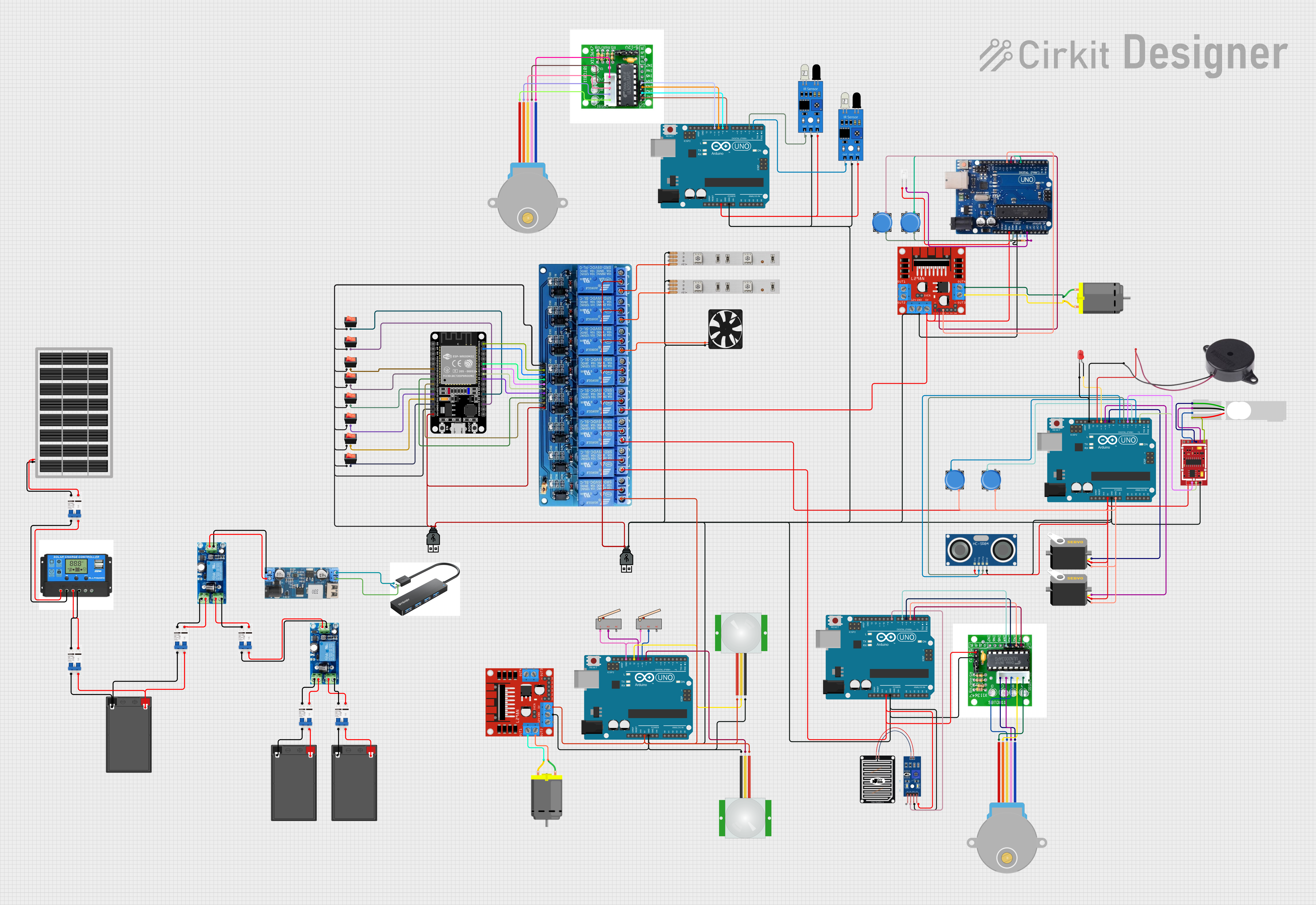
Cirkit Designer
Your all-in-one circuit design IDE
Home /
Project Documentation
Multi-Function Sensor-Integrated Control System with Power Management and Actuator Drivers

Circuit Documentation
Summary
The circuit in question appears to be a complex system involving multiple microcontrollers, sensors, actuators, power management modules, and user interface elements. The system is likely designed for automation and control purposes, with the ability to sense environmental conditions, manage power, and control devices such as motors and relays.
Component List
Microcontrollers
- Arduino UNO: A microcontroller board based on the ATmega328P, with digital input/output pins, analog inputs, and various power options.
Sensors
- IR Sensor: Used for detecting obstacles or for simple communication via infrared waves.
- PIR Sensor: Passive infrared sensor used for motion detection.
- RAIN SENSOR: Detects rain or water presence.
- HC-SR04 Ultrasonic Sensor: Measures distance by emitting ultrasonic waves and measuring the time taken for the echo to return.
- Phototransistor: Senses light levels.
- HX711 Weighing Sensor Module: Precision 24-bit analog-to-digital converter (ADC) for weighing scales.
Actuators
- DC Motor: Converts electrical energy into mechanical rotation.
- Servo: A rotary actuator that allows for precise control of angular position.
- 28BYJ-48 Stepper Motor: A small stepper motor for precise rotational movement control.
- Fan: An electric fan for cooling or ventilation.
- LED Strip: A strip of LEDs used for lighting.
- Buzzer: An audio signaling device.
Power Management
- 12v 7ah Battery: Provides a 12V power source with a capacity of 7 ampere-hours.
- UPS Module: Uninterruptible power supply module for power backup.
- 12v to 5v Step Down Power Converter: Converts 12V to a regulated 5V output.
- Charge Controller: Manages the charging of batteries from solar panels.
- DC MCB: Direct current miniature circuit breaker for overcurrent protection.
User Interface
- Rocker Switch: A switch that rocks back and forth to open or close the circuit.
- Pushbutton: A simple switch mechanism for controlling some aspect of a machine or process.
- Limit Switch: A switch operated by the motion of a machine part or presence of an object.
Others
- USB HUB: A device that expands a single Universal Serial Bus (USB) port into several so that there are more ports available.
- Resistor: A passive two-terminal electrical component that implements electrical resistance as a circuit element.
Wiring Details
Microcontrollers
- Arduino UNO: Connected to various sensors, actuators, and power modules via its digital and analog pins.
Sensors
- IR Sensor: Powered by 5V and ground from an Arduino UNO, with signal output connected to digital pins on the Arduino.
- PIR Sensor: Powered by 5V and ground, with signal output connected to digital pins on an Arduino UNO.
- RAIN SENSOR: Powered by 5V and ground, with digital output connected to an Arduino UNO.
- HC-SR04 Ultrasonic Sensor: Powered by 5V and ground, with trigger and echo pins connected to digital pins on an Arduino UNO.
- Phototransistor: Connected to an analog input on an Arduino Uno R3 through a resistor.
- HX711 Weighing Sensor Module: Powered by 5V and ground, with data and clock lines connected to digital pins on an Arduino UNO.
Actuators
- DC Motor: Connected to an L298N DC motor driver.
- Servo: Powered by 5V and ground, with control signal connected to digital pins on an Arduino UNO.
- 28BYJ-48 Stepper Motor: Connected to a ULN2003 Driver, which interfaces with an Arduino UNO.
- Fan: Powered by 5V and ground.
- LED Strip: Powered by a 12V source through a relay module.
- Buzzer: Powered by a digital pin on an Arduino UNO and ground.
Power Management
- 12v 7ah Battery: Connected to UPS modules, charge controller, and DC MCBs.
- UPS Module: Connected to batteries, DC MCBs, and a step-down power converter.
- 12v to 5v Step Down Power Converter: Input connected to UPS module output, with 5V output powering a USB HUB.
- Charge Controller: Connected to solar panels and batteries through DC MCBs.
- DC MCB: Protects various components by breaking the circuit in case of overcurrent.
User Interface
- Rocker Switch: Controls the power flow to various components.
- Pushbutton: Connected to ground and digital pins on an Arduino UNO for user input.
- Limit Switch: Connected to ground and digital pins on an Arduino UNO for position sensing.
Others
- USB HUB: Powered by a 5V output from a step-down power converter.
- Resistor: Connected to a phototransistor and an analog input on an Arduino Uno R3.
Documented Code
Arduino UNO (Instance ID: dfb0ceb0-aa2d-437e-b2f9-3c4ea9812e11)
#include <Servo.h>
Servo tap_servo;
int sensor_pin = 4;
int tap_servo_pin = 5;
int val;
void setup(){
pinMode(sensor_pin, INPUT);
tap_servo.attach(tap_servo_pin);
}
void loop(){
val = digitalRead(sensor_pin);
if (val == 0){
tap_servo.write(0);
}
if (val == 1){
tap_servo.write(180);
}
}
Arduino UNO (Instance ID: 2d161d47-a51e-43a4-8b51-925c75c8aefe)
#include <Servo.h>
Servo tap_servo;
int sensor_pin = 4;
int tap_servo_pin = 5;
int val;
void setup(){
pinMode(sensor_pin, INPUT);
tap_servo.attach(tap_servo_pin);
}
void loop(){
val = digitalRead(sensor_pin);
if (val == 0){
tap_servo.write(0);
}
if (val == 1){
tap_servo.write(180);
}
}
Arduino UNO (Instance ID: fc4f31b6-e1df-40fc-91d3-c37d2ffa666f)
void setup() {
// put your setup code here, to run once:
}
void loop() {
// put your main code here, to run repeatedly:
}
Arduino UNO (Instance ID: 192f6db1-3c62-4d20-9dbe-ef0e300f4aac)
void setup() {
// put your setup code here, to run once:
}
void loop() {
// put your main code here, to run repeatedly:
}
(Note: The code provided for some instances is identical or empty, which may indicate a need for further development or a placeholder for future code.)